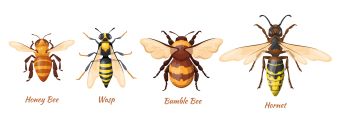
It would be easy to lump every buzzing, yellow, stinging insect into the same category. But when it comes to bees, wasps, and hornets, there's more than meets the eye. Understanding what sets these insects apart can help you appreciate the helpful ones and stay cautious around the more aggressive types.
Characteristics of bees
Bees are generally small, fuzzy insects with black and yellow stripes. There are many species, each with its own distinct striping pattern—some have consistent bands across the body, while others show only a single stripe. Male and female bees can also be told apart by the number of segments on their antennae and abdomens.
Honey bees are known for their role in pollination and their gentle nature. They can only sting once, as their stinger remains lodged in the skin, often resulting in the bee’s death. However, they rarely sting humans and usually reserve this defense for other bees.
Bees play a vital role in pollinating plants, supporting ecosystems, and agriculture alike. Without them, many crops would struggle to grow. Because of their importance, bees are often introduced to farms during key pollination seasons. Unfortunately, they are sensitive to environmental stressors such as pesticide use and habitat destruction, both of which can contribute to declining bee populations.
Characteristics of wasps
Wasps vary widely by species, but some common traits include less body hair than bees and longer wings. Unlike bees, wasps are predators or parasites feeding on other insects rather than nectar. They do not produce honey and contribute very little to pollination.
A common example in North America is the yellowjacket. These wasps build paper-like nests in hidden locations, such as inside trees, underground, or in structures like sheds and outdoor furniture. Wasps can be aggressive, and their stings are painful. They’re also easily provoked by sudden movement, making infestations difficult to manage without professional help.
Characteristics of hornets
While true hornets are not native to North America, the bald-faced hornet is a type of wasp often mistaken for one. These insects build large, visible nests hanging from tree branches. Their nests can grow to the size of a soccer ball.
Bald-faced hornets are black with white markings on their heads and thoraxes. Like other wasps, they can sting multiple times and will defend their nests if threatened.